Things To Do
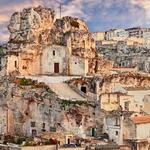
Matera
Matera is an enchanting town in southern Italy, known for its unique history, stunning landscapes, and ancient cave dwellings called "Sassi." Often described as the "City of Stones," Matera is a UNESCO World Heritage site and one of the oldest continuously inhabited places in the world, with roots that go back thousands of years. The Sassi, carved into limestone cliffs, create a breathtaking, otherworldly landscape that has captured the hearts of travelers and filmmakers alike. You can wander through its labyrinth of stone pathways, explore historic churches and museums, and take in spectacular panoramic views of the gorge.
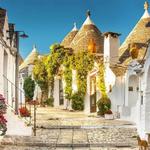
Alberobello
Alberobello is a picturesque town famous for its unique "trulli" houses. These whitewashed, cone-roofed buildings give the miniature city a storybook charm and have earned it a place as a UNESCO World Heritage site. Trulli are crafted from limestone and stacked without mortar, creating a whimsical and distinctly Italian architectural style that dates back centuries. The best time to visit is early evening to stroll through the quaint streets, lined with trulli shops, cafes, and historic churches.
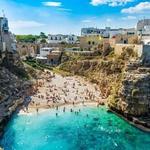
Polignano a Mare
Polignano a Mare is a stunning coastal town in southern Italy, perched on dramatic cliffs overlooking the Adriatic Sea. It's best known for it's crystal-clear turquoise waters, winding whitewashed streets, and breathtaking views. The town’s picturesque beach, nestled between cliffs, is perfect for a day of sun and relaxation, while the historic center is full of charming alleyways filled with artisan shops, cafes, and scenic viewpoints. Polignano is also famous for its culinary delights, especially fresh seafood and gelato.
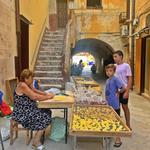
Bari
Bari is the capital of Apulia, and a great place to spend a day or two with lots to see - including churches, castles, and historic neighborhoods with Nonna's handmaking orecchetti: Basilica San Nicola: A white-limestone church built in 1089 for the relics of St. Nicholas of Myra. Bari Vecchia: The oldest part of the city, surrounded by stone walls, with cobbled streets, churches, and the Basilica of St Nicola. Piazza del Ferrarese: A port-side plaza with palm trees, medieval structures, and views of docked boats. Castello Normanno-Svevo: A 12th century fortress with sturdy walls and towers, plus exhibitions and panoramic views. Teatro Petruzzelli: Italy's fourth largest theater, built between 1898 and 1903. Lungomare e Murat: Lovely promenade on the coast for a stroll, especially in the evening. Piazza Mercantile: A square in the old town with great food, bars, and cafes. Centro Storico: Seaside neighborhood with a historic center, beaches, panoramic terraces, and live music.

Monopoli
Monopoli is a famous port town on the Adriatic sea with medieval churches and castles, and bright blue fishing boats against whitewashed harbor walls. It's has many historic sites, including the Baroque cathedral its famous for, a lighthouse and beaches: Cattedrale Maria Santissima della Madia: An 18th-century cathedral dedicated to the city's patron saint Centro Storico di Monopoli: The historic city center is a quaint area with white buildings, hanging laundry, and colorful houseplants Porto antico di Monopoli: The old port is a must-see attraction with a great view Palazzo Palmieri: An 18th-century noble palace with a sumptuous façade and refined interiors Porto Marzano Beach: A small beach with a sandy bottom, but little or no shade Monopoli Lighthouse: Located by the harbor, this lighthouse offers views of the Adriatic Sea Piazza Vittorio Emanuele II: This piazza features anti-aircraft shelters from World War II that are now accessible to visitors
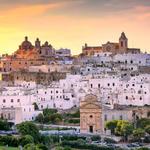
Ostuni
This small hilltop city is known as the "White City",for its characteristic whitewashed historic centre and maze of narrow streets. This ancient city overlooks both the Mediterranean and the Itria Valley, is a great stop offering a combination of history, traditions, delicious food and splendid beaches. You can spend a day wandering the historic center with it's Aragonese walls, it preserves the structure of a medieval village, with narrow streets that intertwine between the whitewashed houses. It's also a great basepoint for going out to see the famous olive groves and trulli of the Itria Valley, and stopping into towns like Alberobello, Locorotondo or the Castellana caves and the villages of Cisternino.

Grotte di Castellana
The “Caves of Castellana”, a vast underground system of karst caves, located approx. 1,5km outside the town of Castellana Grotte, is an important tourist attraction and generally defined as one of the most beautiful and spectacular cave systems in Italy. Winding along a 3 km long itinerary, at a depth of 122 meters below sea level, the tour takes you through millennia old caverns, canyons, deep abysses, fossils, stalactites, stalagmites, and dripstones of incredible shapes and striking colors.

Locorotondo
Locorotondo, nestled in the Valle d'Itria, is a stunning example of Puglia's unique charm. The town's name means "round place," reflecting its circular layout and the way it gracefully wraps around the hilltop it sits on. Known as the "balcony of the Valle d'Itria”, Locorotondo provides a picturesque panorama of the agricultural landscape below. You'll find winding streets leading to the central piazza, where white-washed buildings are punctuated with colourful flower boxes and baroque palaces. The old protective walls trace a perimeter road that offers breathtaking views of the surrounding landscape—a patchwork of vineyards, olive groves, and trulli. You can explore the historic centre of Locorotondo’s old town, pass by the Church of St. George or the Church of the Madonna della Greca. Then try a glass of Locorotondo DOC wine from the Cantina Sociale and the local specialty: u tridde, fresh-made pasta with pecorino and finely chopped parsley, in a wholesome turkey broth.

Castel del Monte

Parco Nazionale del Gargano
Gargano is the largest national park in Italy, on a small peninsula jutting out into the Adriatic Sea. Known as the Spur of Italy, it's home to some of the most diverse landscapes in Apulia, with white limestone cliffs plunge into the aquamarine sea, small towns sit on top of these cliffs, and a thick forest and groves of olive trees cover the interior section of the peninsula. The central hilly portion is a UNESCO World Heritage site, Foresta Umbra, a dense forest of oak and beech trees - while these once covered much of Italy and the Apennine Mountains, the park preserves this last remaining patch in Italy. The highest point of the Gargano Peninsula is Monte Calvo at 1,065 meters (3,494 feet). A few hill towns dot the mountainous landscape. If you're looking for an amazing experience you can also visit the sea caves by boat from Vieste.

Monte Sant'Angelo
This small town and the sanctuary within it are a UNESCO Heritage sight with a castle, a maze of streets to explore, and one of the most sacred cave churches in the world. Monte Sant’Angelo is located high in the mountains. To get here, you will drive on twisting, mountain roads with views of the hilly interior and the Adriatic Sea. It is a very scenic drive, and you can gaze out over small farms and fields of olive trees. The highlight of town is the Sanctuary of San Michele Arcangelo, it's one of the most famous cave churches in the world, dating back to 460 AD. During the Middle Ages, it was one of the most important pilgrimage sites in the world. It's also worth a visit to the Castle of Monte Sant’Angelo which provides amazing panoramic views over the area. You can also visit the Church of the Most Holy Trinity or the Church of Saint Mary Maggiore in town.
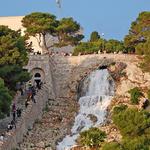
Santa Maria di Leuca
Santa Maria di Leuca sits on the southernmost tip of the Salento peninsula where the waters of the Adriatic Sea mix with those of the Ionian. Leuca derives from the Greek "Leukos," or luminous, and refers to the religious sanctuary built on a site high above the town’s harbour. It's a captivating town, popular with Puglians for the eye-catching Art Nouveau villas that line its seafront. It also hosts a variety of nearby sandy beaches, and its seafront promenade is equipped with lidos, bars and restaurants: Explore historic sites: Visit the Basilica De Finibus Terrae (a historic religious pilgrimage site), see the iconic 16th-century watchtower and lighthouse. Relax on the sandy beaches at Felloniche, Posto Vecchio, Torre Vado, and Pescoluse or explore the dramatic coastlines rocky cliffs and 30 Karstic grottoes on a boat tour. Visit Puglia's monumental aqueduct, a man-made waterfall with a cascade flanked by 300 steps and a Roman column - opened only a few times a year.